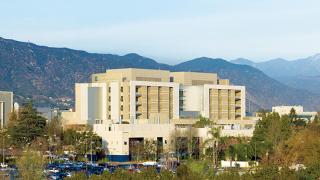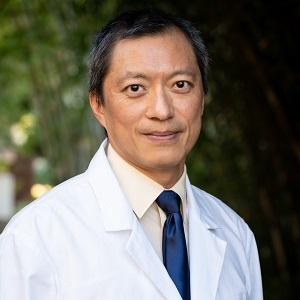It happened aboard an American Airlines flight from Miami to Los Angeles. The passenger, a man in his 30s with diabetes, was experiencing a hypoglycemic episode, his blood sugar dropping very low — a dangerous condition that can cause seizures, confusion, loss of consciousness, even death.
Juk Ting, D.O., was seated a few feet away. Identifying himself as a physician, Ting told the flight attendants to bring some orange juice and extra sugar. With Ting’s help, the passenger gradually revived.
Now the pilot had a decision to make: Did the passenger require hospitalization, and if so, would it be necessary to divert the flight to the nearest airport?
Ting calmly walked to the cockpit.
"I told him to just ACAR the company," he recalled, "and inform L.A. Operations to have the medics stand by to do a medical screening before letting the passenger deplane, for his safety. I also said, ‘Please inform ATC we will need speed relief from the STAR and will need priority landing. I'll be happy to speak to Medlink.’”
That’s when a lot of mouths dropped open.
Who is this guy, they wondered, this doctor speaking perfect pilot jargon, spelling out detailed medical, airport and landing procedures? (For the record, ACAR is the satellite-based Aircraft Communications Addressing and Reporting System, ATC is Air Traffic Control, STAR stands for Standard Terminal Arrival Routing and Medlink is an on-call service that provides inflight medical advice to pilots via satellite phone.)
He’s one of City of Hope’s newest physicians and an assistant clinical professor in the Department of Medicine, Division of Hospital Medicine. He helps take care of City of Hope’s hospitalized patients.
Specializes in critical care
“My specialty is emergency medicine and critical care. I want to be as helpful as I can when people are in their most desperate state of need,” said Ting, who has over 20 years of experience both as a critical care hospitalist and an emergency medicine physician.
But he’s also a licensed commercial pilot who flies jumbo jets — the Boeing 747, which he’s dreamed about since he first saw it as a child, and the newer, infinitely more complex 777.
“I love medicine,” he said. “And I love flying.”
How on earth does he handle both at the same time?
Quite well.
“He’s a really good doctor: compassionate, hard-working, full of energy,” said Jane Zendarski, D.O., a physician at WellSpan Good Samaritan Health System in Lebanon, Pennsylvania. They met in medical school, studied together, listened to country music and shared meals prepared in Ting’s rice cooker. Zendarski, who’d previously worked as a physician’s assistant, helped Ting convert book knowledge into clinical skills. Ting likes to say Zendarski “carried me through med school.” She says, “We carried each other.”
What about his unusual “second” career?
“I don’t know how he does it all,” she said.
But Captain Jin Kang does know.
“He’s a very sharp guy with amazing mental capacity,” said Kang, a line check airman for Southern Air, a provider of air cargo charters. He trained Ting on the “flying computer” that is the 777, and he admits to thinking “What are you doing here?” when this middle-aged doctor showed up to apply for the training program.
“You don’t see that a lot,” Kang said. “Most folks start at a much earlier age because it’s such a very long ladder.”
Aviation was always a dream
“But [Ting] said this was a dream of his, a passion. He also had this great ability to compartmentalize [his medical and aviation training].”
The obvious question hung in the air: Would you rather be Ting’s passenger… or his patient?
Without hesitation Kang and Zendarski immediately gave the identical answer:
“Both! No problem!”
Both passions have dominated Ting’s life.
As a child in Taiwan, he remembers seeing his father, a family physician, treat patients.
“It was so satisfying for him, helping people, getting close to his patients,” he recalled. “Watching him made me want to go in that direction.”
It was a tougher-than-expected path.
Arriving in the U.S. as a shy teen, Ting barely spoke English, and what little he did know he’d learned the old-fashioned way — straight memorization, with very little understanding.
He found an unorthodox way to absorb American-style English. “I watched ‘Three’s Company!’ [the ABC sitcom starring John Ritter]. I imitated Jack Tripper [Ritter’s character]. I always wanted to thank him for that!”
The language barrier held him back at first, affecting his grades and his prospects. But as he began to “re-learn everything,” his fortunes changed. Ting graduated from Virginia Commonwealth University, attended Philadelphia College of Osteopathic Medicine, and ultimately became board certified in emergency medicine.
Along the way he picked up some interesting gigs.
A Decade with the Dodgers
He spent 11 seasons with the Los Angeles Dodgers as stadium physician, handling emergencies in the stands as well as on the field. Look him up on YouTube. On April 26, 2008 home plate umpire Kerwin Danley was struck on the jaw by a 96-mph Brad Penny fastball. The guy in the green scrubs next to the ambulance … that’s Ting.
He served as a flight physician for three years in Cleveland, rescuing sick or injured patients by helicopter and performing emergency procedures in the air as the chopper raced back to the hospital.
Leave it to Ting to find a medical job involving air travel.
As a kid, he loved to watch planes in the movies. He’d ride past the local airport every day on the school bus, wishing he could learn to fly.
During his residency, he took flying lessons “as a way to relieve stress.” By 2000, he had his pilot’s license. But even as his medical career advanced, flying remained only a hobby until 2015, when his youngest daughter went off to college.
“This is my chance,” he realized.
Since then he’s maintained a steady two-weeks-on, two-weeks-off schedule flying Boeing 747s for different freight carriers around the country while continuing to work shifts as an ER physician and a hospitalist. Far from wearing him out, Ting says one profession informs the other. Each forces you to prioritize when bad things happen. Rule One: Don’t panic when the alarm goes off. Keep the patient alive. Keep flying the plane. Methodically handle the most serious challenges or difficulties in order of importance.
Nevertheless, why would you make such an already daunting dual-career life even harder by choosing emergency medicine, possibly the toughest job for any doctor?
“I don’t like to see people suffer,” he said. “When I see people in distress, I just want to help.”
He’ll have plenty of opportunities at City of Hope, his first time at a cancer facility.
“It’s a world-famous hospital and it’s a great honor to be here,” he said. “To be the best, you have to join the best.”
And what if, one day, this pilot/physician needs to make a choice?
No contest. Medicine wins.
“If I must give up flying, so be it. I’ve already flown the queen of the sky — the 747. My dream has been realized.
“Now let’s go make people better.”

